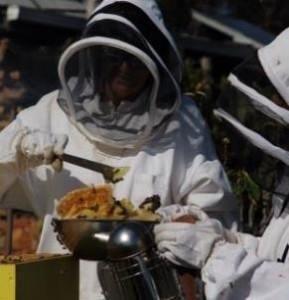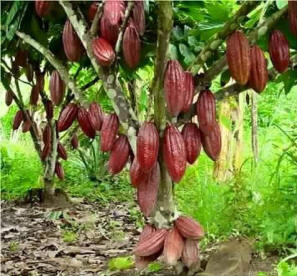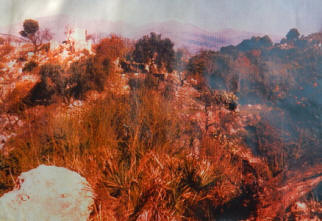|
Jesus Manuel Pineda Rivas (photo right), wrote from Mérida, Venezuela: |
 Continue reading “Homa Farm of Don Ismael in Barinas, Venezuela” Continue reading “Homa Farm of Don Ismael in Barinas, Venezuela” |
Agnihotra on ‘Gavisa’ Farm in Togo, West Africa
|
Marco Brutschin (Photo right with his friend Komla, a farmer in Togo, West Africa) shares his experience: |
 |
|
"My farmer friend Komla from the village Yépévié, Kpalime in Togo, told me, that after starting with Agnihotra, despite the current drought, it rained heavily on his farm, but not in the surrounding areas. Continue reading “Agnihotra on ‘Gavisa’ Farm in Togo, West Africa” |
|
Homa Farm of Dr Jaime Montufar, Guayaquil, Ecuador
|
Dr. Jaime Montufar from Guayaquil, "I’ve been practicing Homa Therapy for 16 years with much love and dedication. The farm we have, through the benefits of Homa Therapy, is now a paradise. . |
|
Homa Farm Tenjo, Colombia
|
Maria Teresa Nuñez Excerpts from Maria Teresa’s letter: |
Homa Farm Joselito, Loma Negra, Piura, Peru
 |
HOMA FARM ‘JOSELITO’ Homa Technician Andres Arango, responsible for the practice of the Homa Fires (photo left) |
|
"In this banana farm we have observed two stages: one without Homa Therapy applications and the other, post or with Homa Technology, when the correct and proper implementation of this Super Technology began. |
|
Organic Farming Experiences with Agnihotra in Australia
– Catherine Menyhart
The impact of performing daily Agnihotra on our land has been significant, yet subtle. I also perform an Om Tryambakam Yajnya for 15 minutes before each Agnihotra, in a separate copper pyramid.
We own 70 bush acres in semi-arid conditions, in Central Victoria, Australia, and found producing organic vegetables, herbs and fruits quite a challenge.
Our topsoil was almost non-existent, but over the years, we have found that by regularly performing Agnihotra, along with organic farming principles, the soil and ecosystem on our property is now rich with healthy growth of plants, vegetables, fruit trees, insects, birds and wildlife.

Our diseased stone fruit trees had healed themselves without any other intervention except daily practice of Agnihotra and liberal application of Agnihotra ash on tree trunks.
We have wicking garden beds to preserve water in this arid climate, but also feed all our produce with Agnihotra ash mixed up in the watering system and composts. Our garden is always healthy and in abundance- such a difference from the past. Seeds from our vegetables are strong and viable.

Our bees thrive, despite the dry heat of summer; in fact, working every day in our gardens we see two other breeds of native bees, which also enjoy the abundance of our gardens and bush land. Our honey is medicinal and we use it mixed with Agnihotra ash for insect bites and other stinging wounds.
Our calendula salves are made with plants grown right next to where we practice Agnihotra and made with our own beeswax, mixed also with a little Agnihotra ash. We have had amazing results for all types of skin diseases when using this.

Each day we wake to an amazing chorus of birdsong, which continues throughout the day– something that was absent before Agnihotra. Animals and birds know when the land is healthy.
We often have feedback from guests, that they feel a sense of rejuvenation, well-being and peace when staying here. Indeed, both my partner and I find it a wrench to leave our property whenever we need to work away from home. We have become sensitive to harmony–it’s quite tangible, this absence of it.
Apart from the physical advantages of practicing daily Agnihotra, we have found that doing this regularly keeps us focused on our spiritual responsibility to actively work at keeping balance and harmony in our lives.
Ecovillage Bhrugu Aranya | A Centre of Light for Europe
 |
Bhrugu Aranya is a blossoming International Ecovillage, the only one of its kind in Poland. Since 1995, Bhrugu Aranya has grown from a small organic farm into a holistic educational centre. |
| Here, in this unique atmosphere, people come to experience healing, meditation, organic gardening and unity with nature on a profound level.
This is an educational centre for learning about Homa Therapy & the Ayurvedic fire practice of Agnihotra in an experiential way. Continue reading “Ecovillage Bhrugu Aranya | A Centre of Light for Europe” |
|
Homa Organic Grapes | Dinkar Patil
|
Dinkar Jayram Patil "In my farm, I grow grapes. Out of the 24 lanes of grapes, 4 were treated with Homa Therapy. |
Mariana Hilgers Story | Malaga, Spain
|
Mariana Hilgers "In 1998, there was nothing at all growing here on our farm due to a severe drought. |
|
Homa Farming in Curacavi, Chile
|
Ms. Karina Ohme from Curacavi, Chile tells her experience of the Amazing recovery of almond and fig trees with Homa Therapy |
|






